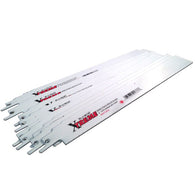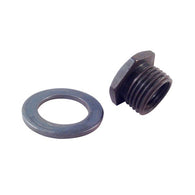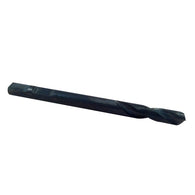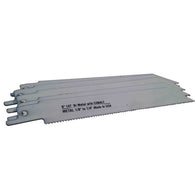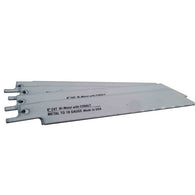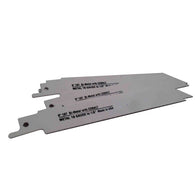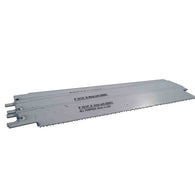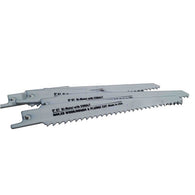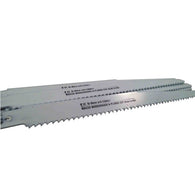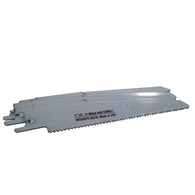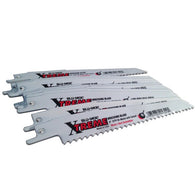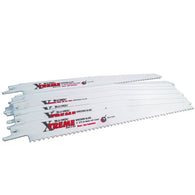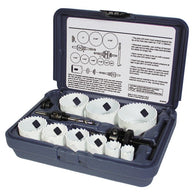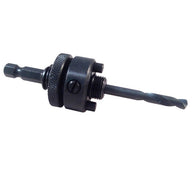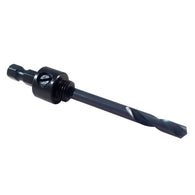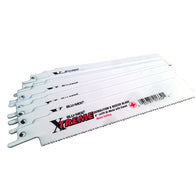Sawing
Reciprocating Saw Blades & Hacksaw Blades
Types of Saws:
Reciprocating Saws
Are saws in which the cutting action is achieved through a push-and-pull "reciprocating" motion of the blade. This type of saw is usually used in construction and demolition. Reciprocating saws can easily cut through a broad range of materials like metal, masonry, wood, fiberglass, and drywall but only if the correct blade is used.
Hacksaws:
Are saws with a metal-framed saw commonly used for cutting plastic, metal, pipes and other materials. The saw has a unique U-shaped bow frame that holds a blade between its spigots (clips) with a handle at the end. The most common hacksaw blade is the 12 inch or 300 mm length. Hacksaw blades have two holes on each end for mounting them in the saw frame, the 12 inch / 300 mm dimension refers to the center to center distance between these mounting holes.
What is TPI?
TPI stands for tooth per inch, this is how blades are measured and categorized for use with hacksaws and reciprocating saws. Most blades come with a measurement in tooth per inch, which refers to the number of teeth available in every inch of its length. The tooth per inch should be used as a guide to determine the minimum thickness of material that a specific blade is used for.
Technical Data:
Reciprocating Blades
- Low TPI blades give faster cuts with rougher edges, recommended for cutting wood.
- High TPI blades give smooth, slow cuts and are the best choice for cutting metal.
- Keep at least three teeth in contact with the material at all times to reduce snagging.
Materials
- Carbon steel blades are flexible and best for cutting wood and plastic.
- High-speed steel (HSS) blades have durable teeth but are prone to breakage.
- Bi-metal blades are a combination of high-speed steel for heat-resistant teeth and a carbon-steel body for flexibility and break-resistance. They last up to 10-times longer than high-carbon steel.
- Carbide-grit blades are best for cutting fiberglass, ceramic tile, and cement board.
Installing a Hacksaw Blade
The proper way to install a hacksaw blade is with the teeth facing forward. Hacksaws are designed to cut when the saw is pushed rather than when pulled. Some blades have an arrow that shows the correct installation (the arrow points toward the handle). Remember to install the blade so it’s tight in the saw and won’t bend. If you do a lot of sawing, you will notice the blade heats up and expands, so be sure to tighten it if it starts to bend.
Installing a Reciprocating Saw Blade
First and most important, unplug the saw or make sure the power is off to the saw. Because the blades are sharp it is recommended to have gloves on to protect your hands from cuts. Depending on the manufacturer, the reciprocating saw might require a flathead screwdriver or a Phillips screwdriver for blade installation. Once you choose the correct blade, loosen the screw and remove the old blade. Insert the new blade and adjust the screw until it is securely in place.
Other Sawing Products:
Bi-Metal Hole Saws:
Hole saws are cylindrical cups with a serrated edge to cut various sizes of holes. The serrated edge cuts the hole while the other end is designed to be driven by an arbor or drill chuck. The most common type of hole saw is the bi-metal hole saw. Bi-metal hole saws are made from high carbon steel and can be used on a number of materials such as wood, plastic, and various metals.
How to use a hole saw:
Hole saws are great for cutting accurate holes in walls and doors but some basic prep work is needed. The first step is to drill a pilot hole by marking where the center of the hole is, and then drill completely through the material. Next, line up the center bit with the pilot hole. Hold the drill with both hands and press straight in. Then, run the drill slowly and adjust the angle until the teeth are contacting uniformly. Increase the drill speed and push in with moderate pressure. After the teeth of the hole saw have cut grooves then run your drill at top speed until you cut through the material.
Mandrel & Pilot Drill
The hole saw mandrel works with bimetal hole saws to drill clean, accurate holes. The mandrel is designed with drive pins that lock the hole saw in place and prevent it from stripping the threads on larger diameter hole saws. Features include an aggressive hex shank and a black oxide finish to resist rust and corrosion.
Need Help? Industrial Tool Supply is always here to help you select the right saw or blade for the job. Feel free to call or contact us online if you need any assistance.

